Novel Formulations of C-Peptide with Long-Acting Therapeutic Potential for Treatment of Diabetic Complications
Abstract
1. Introduction
2. Materials and Methods
2.1. Materials
2.2. Methods
2.2.1. Synthesis and Polymer Characterization
2.2.2. Preparation and Characterization of Nanospheres
2.2.3. Synthesis of C-Terminal Fragment of C-Peptide
2.2.4. In Vitro Biodegradation Study
2.2.5. Particle Surface Modification with Peptides
2.2.6. Encapsulation of C-Peptide
2.2.7. Drug Release
2.2.8. Cell Culture Experiments
2.2.9. Microcalorimetric Ex Vivo Assay of Na+/K+-ATPase on Living Erythrocytes
3. Results and Discussion
3.1. Polymerization and Polymer Characterization
3.2. Preparation and Characterization of Nanospheres
3.3. In Vitro Biodegradation Study
3.4. Surface Modification
3.5. C-Peptide Encapsulation
3.6. Drug Release
3.7. Cell Culture Experiments
3.8. Microcalorimetric Study
4. Conclusions
Supplementary Materials
Author Contributions
Funding
Acknowledgments
Conflicts of Interest
References
- Sima, A.A.F. Diabetes & C-Peptide: Scientific and Clinical Aspects; Springer: New York, NY, USA, 2012; pp. 1–169. [Google Scholar]
- Luzi, L.; Zerbini, G.; Caumo, A. C-peptide: A redundant relative of insulin? Diabetologia 2007, 50, 500–502. [Google Scholar] [CrossRef] [PubMed]
- Li, Y.; Zhao, D.D.; Li, Y.; Meng, L.; Enwer, G. Serum C-peptide as a key contributor to lipid-related residual cardiovascular risk in the elderly. Arch. Gerontol. Geriatr. 2017, 73, 263–268. [Google Scholar] [CrossRef] [PubMed]
- Shpakov, A.O. Mechanisms of Action and Therapeutic Potential of Proinsulin C-peptide. J. Evol. Biochem. Physiol. 2017, 53, 180–190. [Google Scholar] [CrossRef]
- Haidet, J.; Cifarelli, V.; Trucco, M.; Luppi, P. C-peptide reduces pro-inflammatory cytokine secretion in LPS-stimulated U937 monocytes in condition of hyperglycemia. Inflamm. Res. 2012, 61, 27–35. [Google Scholar] [CrossRef] [PubMed]
- Leighton, E.; Sainsbury, C.A.; Jones, G.C. A Practical Review of C-Peptide Testing in Diabetes. Diabetes Ther. 2017, 8, 475–487. [Google Scholar] [CrossRef] [PubMed]
- Walcher, D.; Babiak, C.; Poletek, P.; Rosenkranz, S.; Bach, H.; Betz, S.; Durst, R.; Grub, M.; Hombach, V.; Strong, J.; et al. C-peptide induces vascular smooth muscle cell proliferation: Involvementof SRC-kinase, phosphatidylinositol 3-kinase, and extracellular signal-regulated kinase 1/2. Circ. Res. 2006, 99, 1181–1187. [Google Scholar] [CrossRef] [PubMed]
- Lachin, J.M.; McGee, P.; Palmer, J.P. Impact of C-Peptide Preservation on Metabolic and Clinical Outcomes in the Diabetes Control and Complications Trial. Diabetes 2014, 63, 739–748. [Google Scholar] [CrossRef] [PubMed]
- Hansen, A.; Johansson, L.; Wahren, J.; von Bibra, H. C-peptide exerts beneficial effects on myocardial blood flow andfunction in patients with type 1 diabetes. Diabetes 2002, 51, 3077–3082. [Google Scholar] [CrossRef]
- Ido, Y.; Vindigni, A.; Chang, K.; Stramm, L.; Chance, R.; Heath, W.F.; DiMarchi, R.D.; Di Cera, E.; Williamson, J.R. Prevention of vascular and neural dysfunction in diabetic rats by C-peptide. Science 1997, 277, 563–566. [Google Scholar] [CrossRef] [PubMed]
- Zhang, W.; Yorek, M.; Pierson, C.R.; Murakawa, Y.; Breidenbach, A.; Sima, A.A.F. Human C-peptide dose dependently prevents early neuropathy in the BB/Wor-rat. Int. J. Exp. Diabetes Res. 2001, 2, 187–193. [Google Scholar] [CrossRef] [PubMed]
- Faber, O.K.; Hagen, C.; Binder, C. Kinetics of human connecting peptide in normal and diabetic subjects. J. Clin. Investig. 1978, 62, 197–203. [Google Scholar] [CrossRef] [PubMed]
- Foyt, H.; Daniels, M.; Milad, M.; Wahre, J. Pharmacokinetics, safety, and tolerability of a long-acting C-peptide (CBX129801) in patients with type 1 diabetes. Diabetologia 2012, 55, S455. [Google Scholar]
- Jolivalt, C.G.; Rodriguez, M.; Wahren, J.; Calcutt, N.A. Efficacy of a long-acting C-peptide analogue against peripheral neuropathy in streptozotocin-diabetic mice. Diabetes Obes. Metab. 2016, 3, 147–153. [Google Scholar] [CrossRef] [PubMed]
- Wahren, J.; Foyt, H.; Daniels, M.; Arezzo, J.C. Long-acting C-peptide and neuropathy in type 1 diabetes: A 12-month clinical trial. Diabetes Care 2016, 39, 596–602. [Google Scholar] [CrossRef] [PubMed]
- Xie, J.; Yang, C.; Liu, Q.; Li, J.; Liang, R.; Shen, C.; Zhang, Y.; Wang, K.; Liu, L.; Shezad, K.; et al. Encapsulation of Hydrophilic and Hydrophobic Peptides into Hollow Mesoporous Silica Nanoparticles for Enhancement of Antitumor Immune Response. Small 2017, 13, 1701741. [Google Scholar] [CrossRef] [PubMed]
- Li, Y.; Na, R.; Wang, X.; Liu, H.; Zhao, L.; Sun, X.; Ma, G.; Cui, F. Fabrication of antimicrobial peptide-loaded PLGA/Chitosan composite microspheres for long-Acting bacterial resistance. Molecules 2017, 22, 1637. [Google Scholar]
- Tang, R.; Wang, X.; Zhang, H.; Liang, X.; Feng, X.; Zhu, X.; Lu, X.; Wu, F.; Liu, Z. Promoting early neovascularization of SIS-repaired abdominal wall by controlled release of bioactive VEGF. RSC Adv. 2018, 8, 4548–4560. [Google Scholar] [CrossRef]
- Agrawal, G.R.; Wakte, P.; Shelke, S. Formulation, physicochemical characterization and in vitro evaluation of human insulin-loaded microspheres as potential oral carrier. Prog. Biomater. 2017, 6, 125–136. [Google Scholar] [CrossRef]
- Maciel, V.B.V.; Yoshida, C.M.P.; Pereira, S.M.S.S.; Goycoolea, F.M.; Franco, T.T. Electrostatic self-assembled chitosan-pectin nano- and microparticles for insulin delivery. Molecules 2017, 22, 1707. [Google Scholar] [CrossRef]
- Bloch, K.; Vanichkin, A.; Gil-Ad, I.; Vardi, P.; Weizman, A. Insulin delivery to the brain using intracranial implantation of alginate-encapsulated pancreatic islets. J. Tissue Eng. Regen. Med. 2017, 11, 3263–3272. [Google Scholar] [CrossRef]
- Alibolandi, M.; Alabdollah, F.; Sadeghi, F.; Mohammadi, M.; Abnous, K.; Ramezani, M.; Hadizadeh, F. Dextran-b-poly (lactide-co-glycolide) polymersome for oral delivery of insulin: In vitro and in vivo evaluation. J. Control. Release 2016, 227, 58–70. [Google Scholar] [CrossRef] [PubMed]
- Saravanan, S.S.; Malathi, M.S.; Sesh, P.S.L.; Selvasubramanian, S.S.; Balasubramanian, B.S.; Pandiyan, P.V. Hydrophilic poly (ethylene glycol) capped poly (lactic-co-glycolic) acid nanoparticles for subcutaneous delivery of insulin in diabetic rats. Int. J. Biol. Macromol. 2017, 95, 1190–1198. [Google Scholar]
- Gupta, R.; Mohanty, S. Controlled release of insulin from folic acid-insulin complex nanoparticles. Colloids Surf. B Biointerfaces 2017, 154, 48–54. [Google Scholar] [CrossRef] [PubMed]
- Habibi, N.; Kamaly, N.; Memic, A.; Shafiee, H. Self-assembled peptide-based nanostructures: Smart nanomaterials toward targeted drug delivery. Nano Today 2016, 11, 41–60. [Google Scholar] [CrossRef] [PubMed]
- Nordquist, L.; Palm, F.; Andresen, B.T. Renal and vascular benefits of C-peptide: Molecular mechanisms of C-peptide action. Biologics 2008, 2, 441–452. [Google Scholar] [CrossRef]
- De La Tour, D.; Raccah, D.; Jannot, M.; Coste, T.; Rougerie, C.; Vague, P. Erythrocyte Na/K ATPase activity and diabetes: Relationship with C-peptide level. Diabetologia 1998, 41, 1080–1084. [Google Scholar] [CrossRef]
- Djemli-Shipkolye, A.; Gallice, P.; Coste, T.; Jannot, M.F.; Tsimaratos, M.; Raccah, D.; Vague, P. The effects ex vivo and in vitro of insulin and C-peptide on Na/K adenosine triphosphatase activity in red blood cell membranes of type 1 diabetic patients. Metabolism 2000, 49, 868–872. [Google Scholar] [CrossRef]
- Wilder, R.; Mobashery, S. The use of triphosgene in preparation of N-carboxy-alpha-amino acid anhydrides. J. Org. Chem. 1992, 57, 2755–2756. [Google Scholar] [CrossRef]
- Vlakh, E.; Novikov, A.; Vlasov, G.; Tennikova, T. Solid phase peptide synthesis on epoxy-bearing methacrylate monoliths. J. Pept. Sci. 2004, 10, 719–730. [Google Scholar] [CrossRef]
- Amoabediny, G.; Haghiralsadat, F.; Naderinezhad, S.; Helder, M.N.; Akhoundi Kharanaghi, E.; Mohammadnejad Arough, J.; Zandieh-Doulabi, B. Overview of preparation methods of polymeric and lipid-based (niosome, solid lipid, liposome) nanoparticles: A comprehensive review. Int. J. Polym. Mater. Polym. Biomater. 2018, 67, 383–400. [Google Scholar] [CrossRef]
- Sasaki, Y.; Kohri, M.; Kojima, T.; Taniguchi, T.; Kishikawa, K. Preparation of polymer nanoparticles via phase inversion temperature Method using amphiphilic block polymer synthesized by atom transfer radical polymerization. Trans. Mater. Soc. Jpn. 2014, 39, 125–128. [Google Scholar] [CrossRef]
- Zhu, Y.; Yi, C.; Hu, Q.; Wei, W.; Liu, X. Effect of chain microstructure on self-assembly and emulsification of amphiphilic poly(acrylic acid)-polystyrene copolymers. Phys. Chem. Chem. Phys. 2016, 18, 26236–26244. [Google Scholar] [CrossRef] [PubMed]
- Yang, T.; Li, W.; Duan, X.; Zhu, L.; Fan, L.; Qiao, Y.; Wu, H. Preparation of two types of polymeric micelles based on poly(β-l-malic acid) for antitumor drug delivery. PLoS ONE 2016, 11, e0162607. [Google Scholar] [CrossRef] [PubMed]
- Prokop, A.; Iwasaki, Y.; Harada, A. (Eds.) Intracellular Delivery II: Fundamentals and Applications; Springer: Heidelberg, Germany, 2014; p. 479. [Google Scholar]
- Marsden, H.R.; Gabrielli, L.; Kros, A. Rapid preparation of polymersomes by a water addition/solvent evaporation method. Polym. Chem. 2010, 1, 1512–1518. [Google Scholar] [CrossRef]
- Tarasenko, I.; Zashikhina, N.; Guryanov, I.; Volokitina, M.; Biondi, B.; Fiorucci, S.; Formaggio, F.; Tennikova, T.; Korzhikova-Vlakh, E. Amphiphilic polypeptides with prolonged enzymatic stability for the preparation of self-assembled nanobiomaterials. RSC Adv. 2018, 8, 34603–34613. [Google Scholar] [CrossRef]
- Zikou, S.; Koukkou, A.-I.; Mastora, P.; Sakarellos-Daitsiotis, M.; Sakarellos, C.; Drainas, C.; Panou-Pomonis, E. Design and synthesis of cationic Aib-containing antimicrobial peptides: Conformational and biological studies. J. Pept. Sci. 2007, 13, 481–486. [Google Scholar] [CrossRef]
- Guo, Q.; Zhang, T.; An, J.; Wu, Z.; Zhao, Y.; Dai, X.; Zhang, X.; Li, C. Block versus Random Amphiphilic Glycopolymer Nanopaticles as Glucose-Responsive Vehicles. Biomacromolecules 2015, 16, 3345–3356. [Google Scholar] [CrossRef] [PubMed]
- Johansson, J.; Ekberg, K.; Shafqat, J.; Henriksson, M.; Chibalin, A.; Wahren, J.; Jörnvall, H. Molecular effects of proinsulin C-peptide. Biochem. Biophys. Res. Commun. 2002, 295, 1035–1040. [Google Scholar] [CrossRef]
- Forst, T.; Kunt, T. Effects of C-peptide on microvascular blood flow and blood hemorheology. Exp. Diabesity Res. 2004, 5, 51–64. [Google Scholar] [CrossRef]
- Jørgensen, P. Sodium and potassium ion pump in kidney tubules. Physiol. Rev. 1980, 60, 864–917. [Google Scholar] [CrossRef] [PubMed]
- Ohtomo, Y.; Bergman, T.; Johansson, B.L.; Jörnvall, H.; Wahren, J. Differential effects of proinsulin C-peptide fragments on Na+, K+- ATPase activity of renal tubule segments. Diabetologia 1998, 41, 287–291. [Google Scholar] [CrossRef] [PubMed]
- Forst, T.; De la Tour, D.D.; Kunt, T.; Pfutzner, A.; Goitom, K.; Pohlmann, T.; Schneider, S.; Johansson, B.L.; Wahren, J.; Lobig, M.; et al. Effects of proinsulin C-peptide on nitric oxide, microvascular blood flow and erythrocyte Na+,K+-atpase activity in diabetes mellitus type I. Clin. Sci. 2000, 98, 283–290. [Google Scholar] [CrossRef] [PubMed]
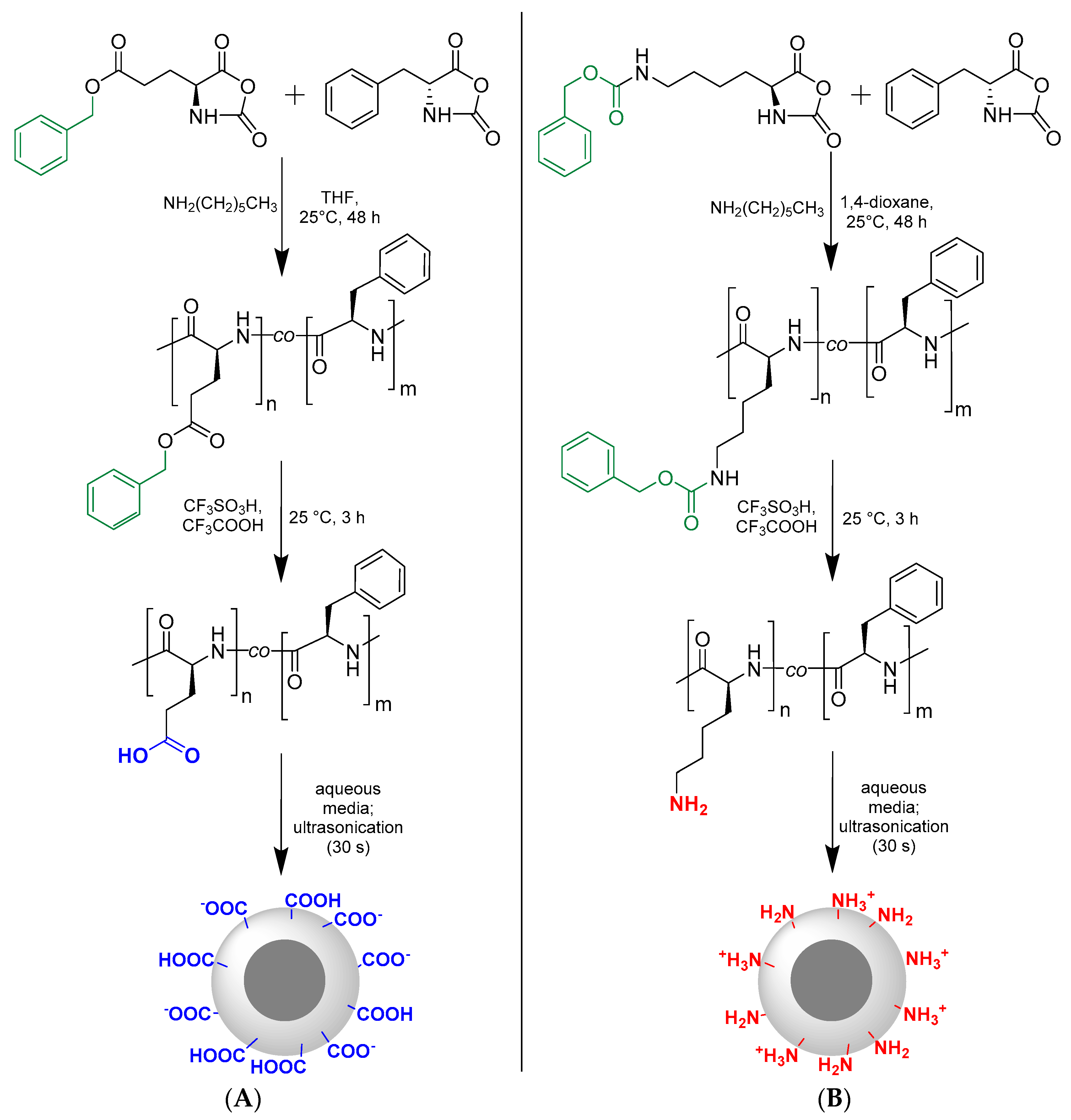
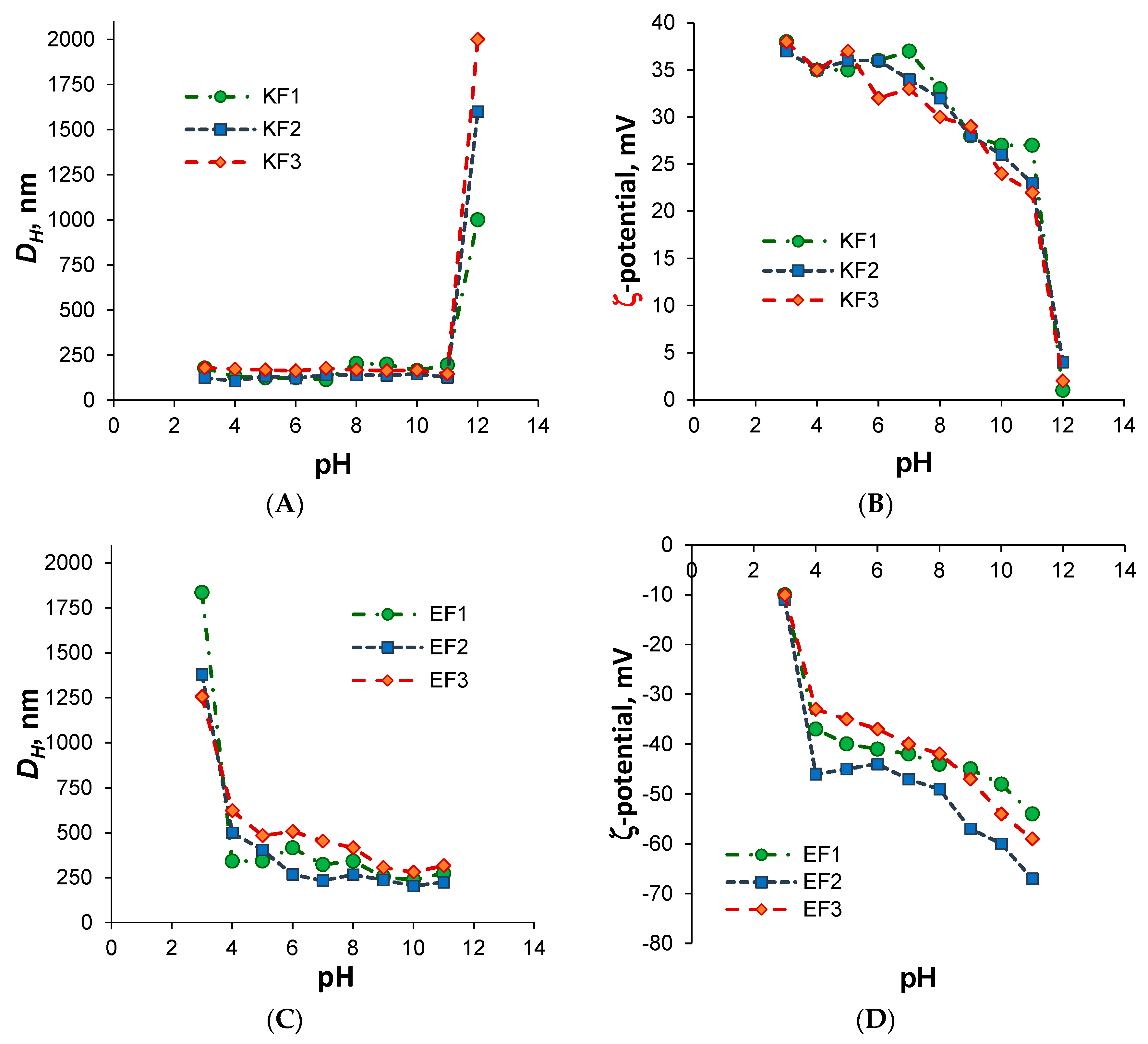
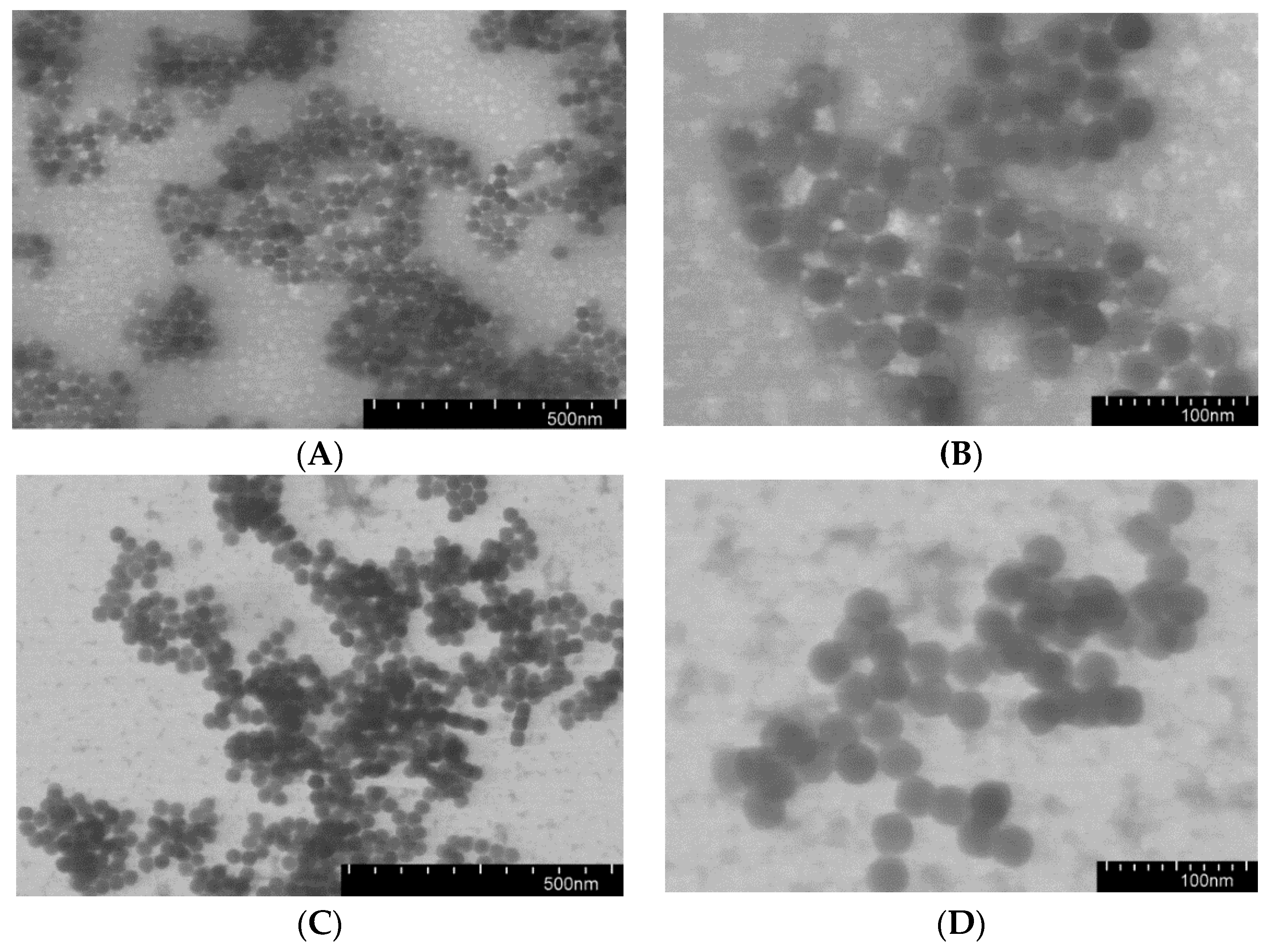

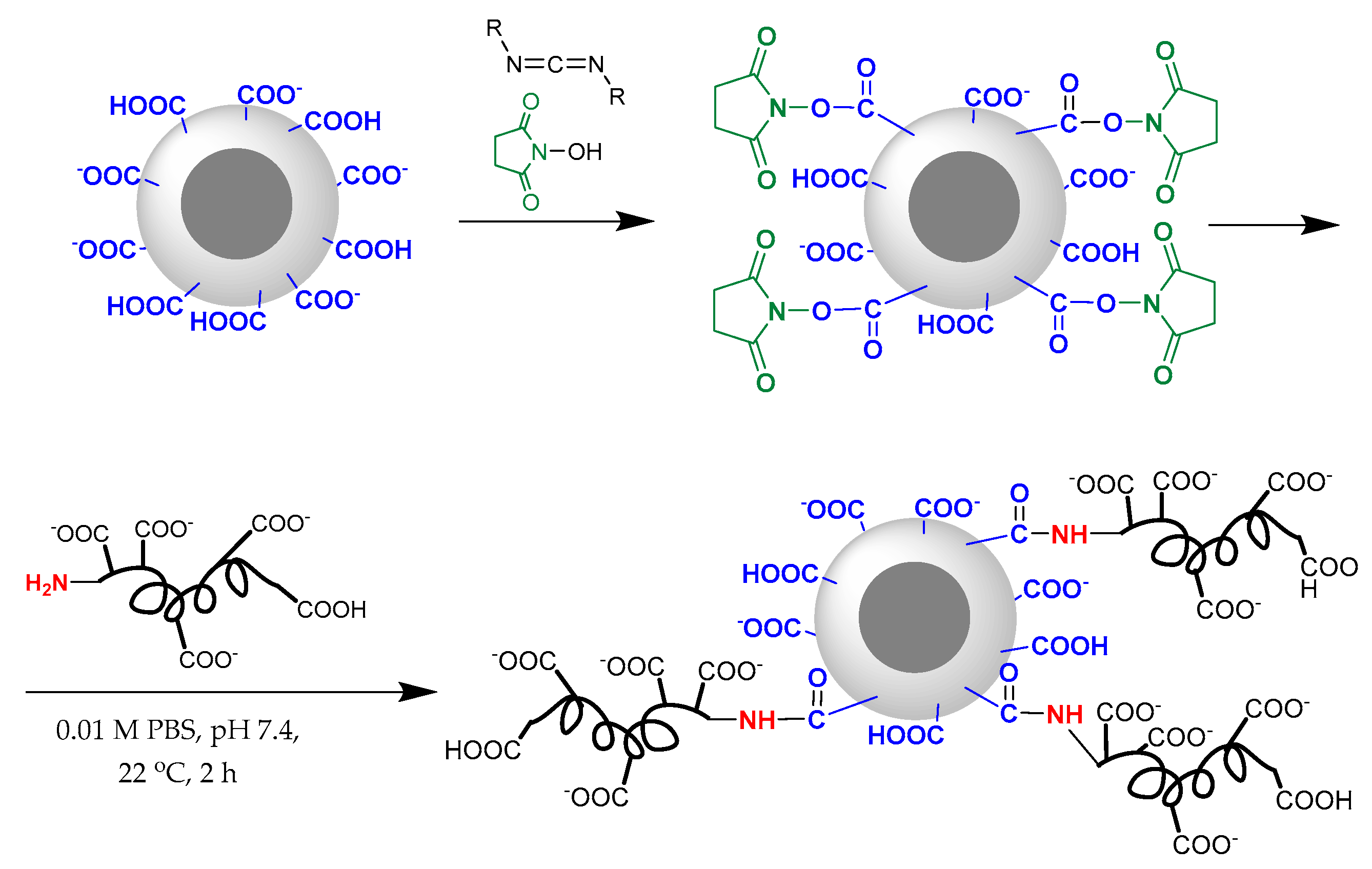


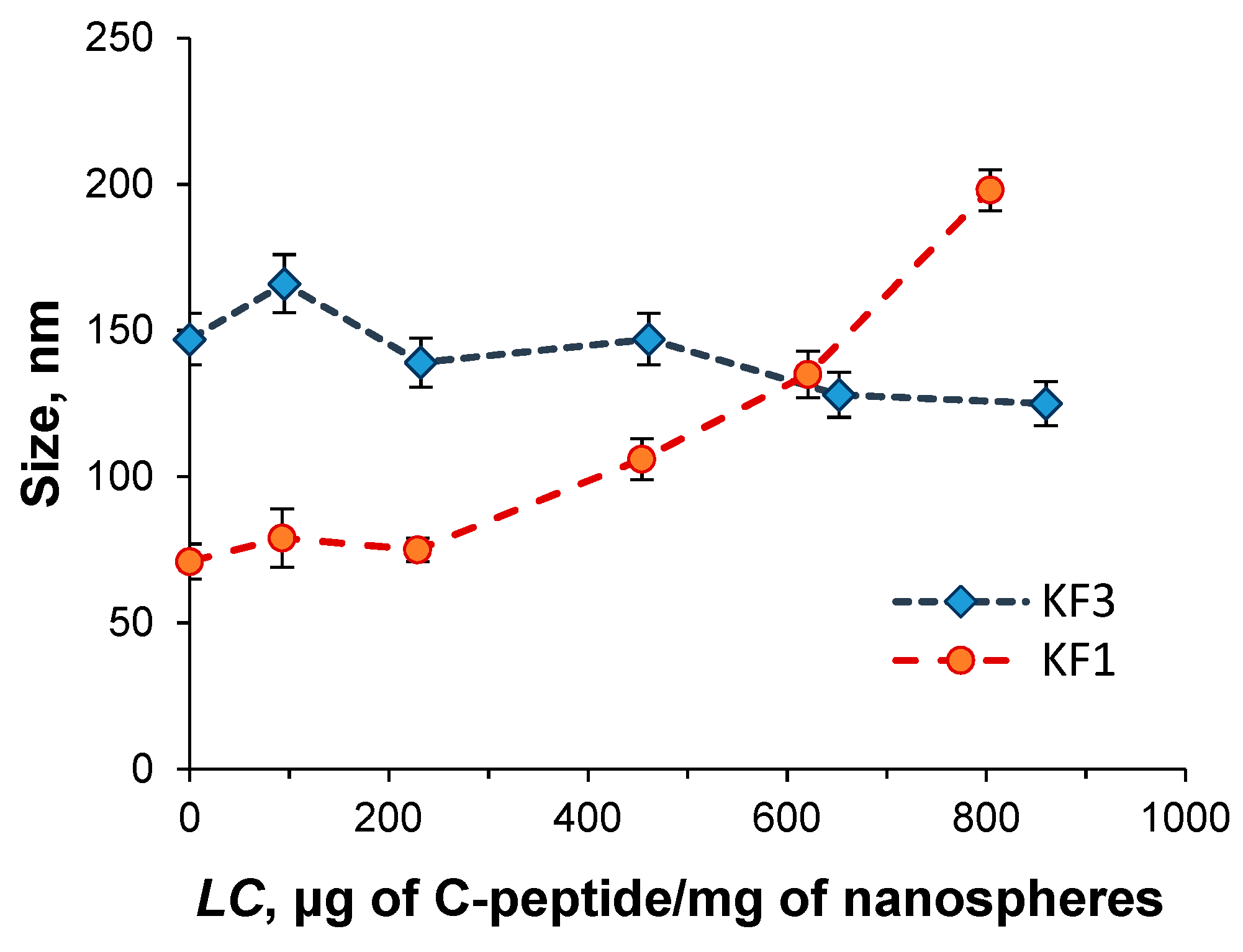
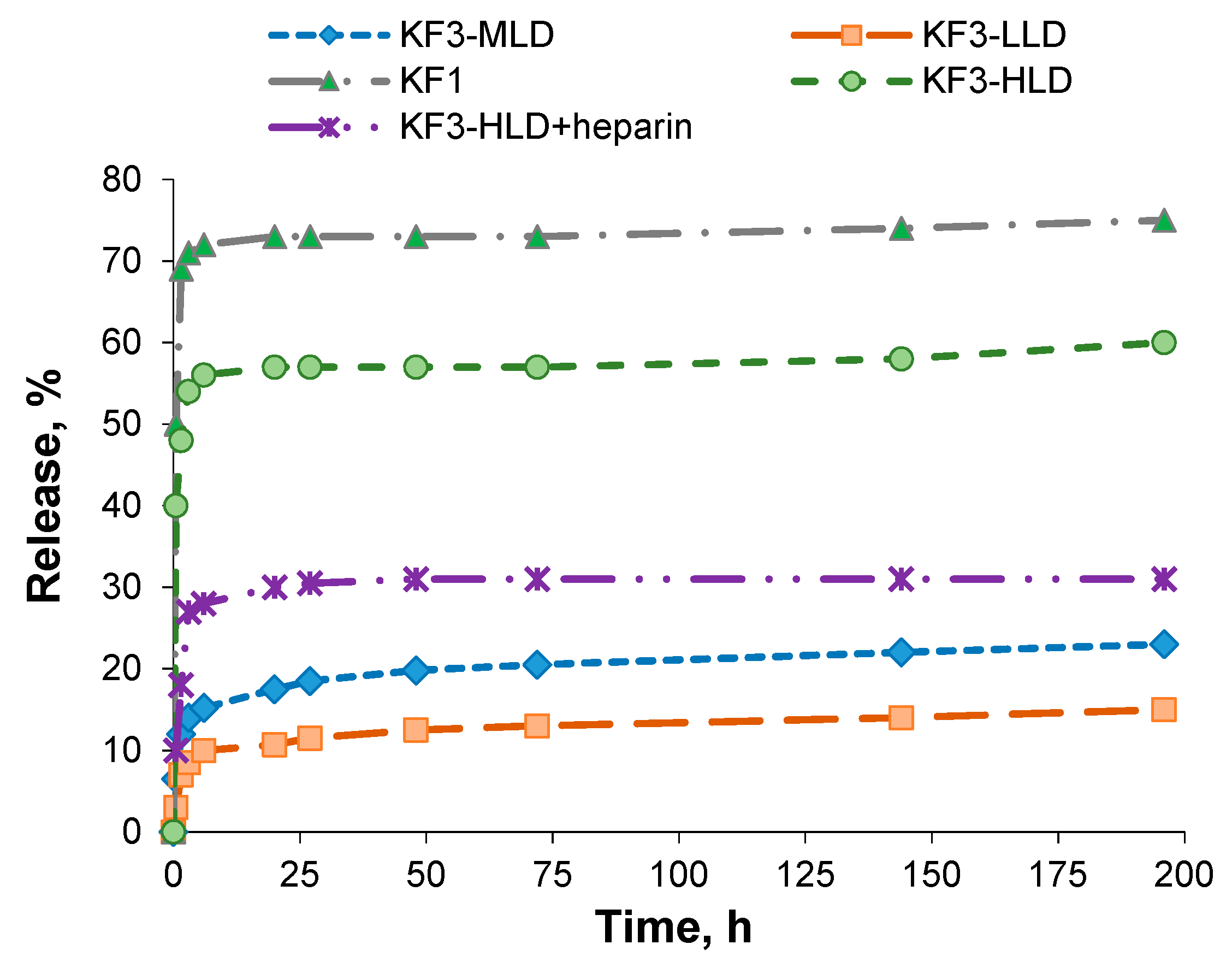
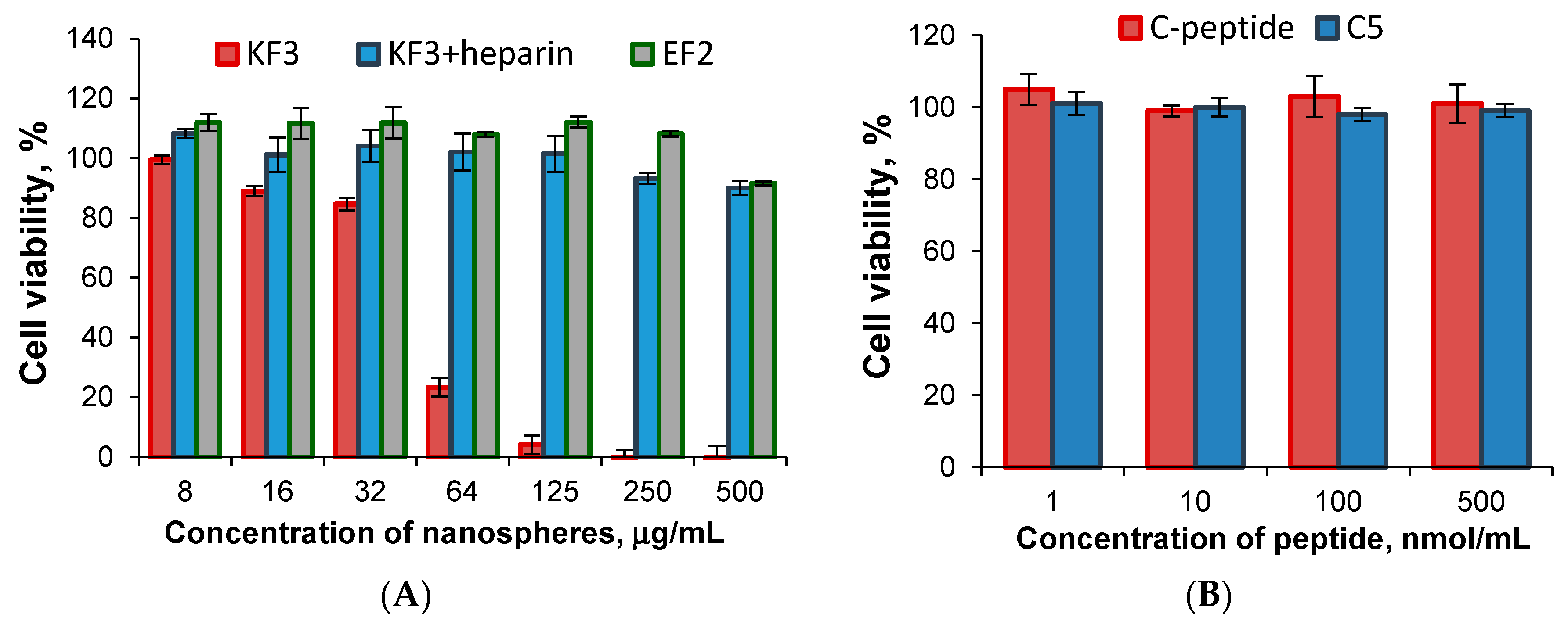

| Sample | Initial Ratio of NKAs: [Glu(OBzl)/Lys(Z)]/[d-Phe] | Polymer Characteristics (SEC) | Polymer Yield, % | ||
|---|---|---|---|---|---|
| Mn | Mw | Ð | |||
| P(Glu(OBzl)n-co-dPhem) | |||||
| E(Bzl)F1 | 1/1 | 5600 | 6400 | 1.15 | 49 |
| E(Bzl)F2 | 4/1 | 6700 | 8100 | 1.20 | 70 |
| E(Bzl)F3 | 8/1 | 7100 | 9200 | 1.29 | 72 |
| P(Lys(Z)n-co-dPhem) | |||||
| K(Z)F1 | 1/1 | 14,000 | 15,800 | 1.07 | 68 |
| K(Z)F2 | 4/1 | 21,500 | 24,300 | 1.13 | 55 |
| K(Z)F3 | 8/1 | 24,300 | 28,000 | 1.15 | 71 |
| Sample | Determined Polymer Composition | |||||
|---|---|---|---|---|---|---|
| HPLC | 1H NMR | |||||
| n | m | [Glu/Lys]/[Phe] Ratio | n | m | [Glu]/[Phe] Ratio | |
| P(Glun-co-dPhem) | ||||||
| EF1 | 17 | 14 | 1.2 | 16 | 15 | 1.1 |
| EF2 | 33 | 11 | 3.0 | 37 | 10 | 3.7 |
| EF3 | 38 | 7 | 5.4 | 45 | 8 | 5.6 |
| P(Lysn-co-dPhem) | ||||||
| KF1 | 34 | 34 | 1.0 | - | - | - |
| KF2 | 72 | 17 | 4.3 | - | - | - |
| KF3 | 87 | 9 | 9.5 | - | - | - |
| Sample | Amount of Bound Peptide, μg/mg of Nanospheres | Amount of Bound Peptide, nmol/mg of Nanospheres | Immobilization Efficiency, % |
|---|---|---|---|
| C-peptide | |||
| EF1 | 20 ± 4 | 5.5 | 10 ± 1 |
| EF2 | 48 ± 5 | 13.3 | 24 ± 2 |
| EF3 | 25 ± 3 | 6.9 | 13 ± 2 |
| C5 | |||
| EF2 | 16 ± 2 | 30.0 | 16 ± 2 |
| Sample | DHo *, nm | EE **, % | LC, µg/mg of Particles | DH encaps *, nm | PDI encaps * |
|---|---|---|---|---|---|
| C-peptide | |||||
| KF1 | 71 ± 3 | 89.5 ± 0.6 | 89.5 ± 0.5 | 79 ± 8 | 0.24 |
| KF2 | 96 ± 3 | 94.6 ± 1.0 | 94.6 ± 0.9 | 130 ± 20 | 0.16 |
| KF3 | 150 ± 10 | 95.0 ± 1.1 | 95.0 ± 1.0 | 190 ± 20 | 0.14 |
| C5 | |||||
| KF3 | 150 ± 10 | 96.2 ± 0.7 | 96.2 ± 0.7 | 178 ± 15 | 0.13 |
| Sample | Amount of C-Peptide Encapsulated, µg/mg of Nanospheres | Amount of C-Peptide Retained after 14 Days Release, µg/mg of Nanospheres |
|---|---|---|
| KF1 | 581 ± 3 | 157 ± 4 |
| KF3-HLD | 604 ± 4 | 259 ± 5 |
| KF3-MLD | 285 ± 5 | 225 ± 7 |
| KF3-LLD | 147 ± 4 | 128 ± 3 |
| KF3-HLD + heparin | 483 ± 8 | 335 ± 10 |
| # | Experimental Condition | ∆H, μJ Normalized to Control |
|---|---|---|
| 1 | C-peptide + ouabain | 0 * |
| 2 | C-peptide | −102 ± 7 * |
| 3 | C5 | −136 ± 9 * |
| 4 | C-peptide encapsulated in KF3 nanospheres (HLD) | −265 ± 19 ** |
| 5 | C-peptide encapsulated in KF3 nanospheres (LLD) | −65 ± 5 ** |
| 6 | C-peptide immobilized on the surface of EF2 nanospheres | −213 ± 16 *** |
| 7 | C5 encapsulated in KF3 nanospheres (LLD) | −54 ± 6 ** |
| 8 | C5 immobilized on the surface of EF2 nanospheres | −15 ± 4 *** |
© 2019 by the authors. Licensee MDPI, Basel, Switzerland. This article is an open access article distributed under the terms and conditions of the Creative Commons Attribution (CC BY) license (http://creativecommons.org/licenses/by/4.0/).
Share and Cite
Zashikhina, N.; Sharoyko, V.; Antipchik, M.; Tarasenko, I.; Anufrikov, Y.; Lavrentieva, A.; Tennikova, T.; Korzhikova-Vlakh, E. Novel Formulations of C-Peptide with Long-Acting Therapeutic Potential for Treatment of Diabetic Complications. Pharmaceutics 2019, 11, 27. https://doi.org/10.3390/pharmaceutics11010027
Zashikhina N, Sharoyko V, Antipchik M, Tarasenko I, Anufrikov Y, Lavrentieva A, Tennikova T, Korzhikova-Vlakh E. Novel Formulations of C-Peptide with Long-Acting Therapeutic Potential for Treatment of Diabetic Complications. Pharmaceutics. 2019; 11(1):27. https://doi.org/10.3390/pharmaceutics11010027
Chicago/Turabian StyleZashikhina, Natalia, Vladimir Sharoyko, Mariia Antipchik, Irina Tarasenko, Yurii Anufrikov, Antonina Lavrentieva, Tatiana Tennikova, and Evgenia Korzhikova-Vlakh. 2019. "Novel Formulations of C-Peptide with Long-Acting Therapeutic Potential for Treatment of Diabetic Complications" Pharmaceutics 11, no. 1: 27. https://doi.org/10.3390/pharmaceutics11010027
APA StyleZashikhina, N., Sharoyko, V., Antipchik, M., Tarasenko, I., Anufrikov, Y., Lavrentieva, A., Tennikova, T., & Korzhikova-Vlakh, E. (2019). Novel Formulations of C-Peptide with Long-Acting Therapeutic Potential for Treatment of Diabetic Complications. Pharmaceutics, 11(1), 27. https://doi.org/10.3390/pharmaceutics11010027









